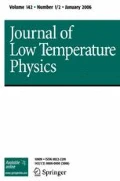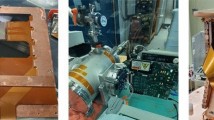Abstract
We describe recent experiments using a SuperCDMS high-voltage single-charge sensitive (HVeV) detector illuminated with an ultraviolet LED (275 nm) and a monochromatic laser (650 nm) using a dual-fiber optic system installed in a small dilution refrigerator at Stanford University. We observed a population of fluorescence background events after UV exposure but not after exposure to the laser source. The fluorescence was likely due to scattered UV photons absorbed outside the detector. We discuss the possibility of fluorescence being a contributor to the low energy excess background observed in above-ground Dark Matter experiments.




Similar content being viewed by others
References
R. Agnese et al., Phys. Rev. Lett. 121, 051301 (2018). https://doi.org/10.1103/PhysRevLett.121.051301
G. Angloher et al., Eur. Phys. J. C 77, 637 (2017). https://doi.org/10.1140/epjc/s10052-017-5223-9
A. Aguilar-Arevalo et al., Phys. Rev. Lett. 118, 141803 (2017). https://doi.org/10.1103/PhysRevLett.118.141803
Q. Arnaud et al., Phys. Rev. D 97, 022003 (2018). https://doi.org/10.1103/PhysRevD.97.022003
M. Crisler et al., Phys. Rev. Lett. 121, 061803 (2018). https://doi.org/10.1103/PhysRevLett.121.061803
R. Essig et al., ArXiv e-printsarXiv:1311.0029
J. Alexander et al., ArXiv e-printsarXiv:1608.08632
R. Essig, J. Mardon, T. Volansky, Phys. Rev. D 85, 076007 (2012). https://doi.org/10.1103/PhysRevD.85.076007
A. Nelson, J. Scholtz, Phys. Rev. D 84, 103501 (2011). https://doi.org/10.1103/PhysRevD.84.103501
B. Holdom, Phys. Lett. B 178, 65 (1986). https://doi.org/10.1016/0370-2693(86)90470-3
Y. Hochberg, T. Lin, K.M. Zurek, Phys. Rev. D 95, 023013 (2017). https://doi.org/10.1103/PhysRevD.95.023013
R.K. Romani et al., Appl. Phys. Lett. 112, 043501 (2018). https://doi.org/10.1063/1.5010699
J. Tiffenberg et al., Phys. Rev. Lett. 119, 131802 (2017). https://doi.org/10.1103/PhysRevLett.119.131802
F. Ponce et al., J. Low Temp. Phys. 199, 598–605 (2020). https://doi.org/10.1007/s10909-020-02349-x
F. Ponce et al., Phys. Rev. D 101, 031101(R) (2020). https://doi.org/10.1103/PhysRevD.101.031101
P. Du, D. Egana-Ugrinovic, R. Essig, M. Sholapurkar, ArXiv e-printsarXiv:2011.13939v1
N.A. Kurinsky, Ph.D. thesis, Stanford University, Dept. Phys. (2018)
B. Neganov, V. Trofimov, Otkrytia i Izobret, 146, 215 (1985), USSR Patent No. 1037771 (1981) (in Russian)
P.N. Luke, J. Appl. Phys. 64, 6858 (1988). https://doi.org/10.1063/1.341976
G.E. Jellison Jr., F.A. Modine, J. Appl. Phys. 53, 3745–3753 (1982). https://doi.org/10.1063/1.331113
M.A. Green, M.J. Keevers, Prog. Photovolt. Res. Appl. 3, 189–192 (1995). https://doi.org/10.1002/pip.4670030303
A.N. Trukhin et al., J. Non-Cryst. Solids 331, 91–99 (2003). https://doi.org/10.1016/j.jnoncrysol.2003.08.080
V. Spizzichino, L. Caneve, F. Colao, L. Ruggiero, Appl. Spectrosc. 70(6), 1001–1008 (2016). https://doi.org/10.1177/0003702816641267
Acknowledgements
This work was supported in part by the US Department of Energy and by the National Science Foundation. PNNL is operated by the Battelle Memorial Institute for the US Department of Energy under contract DE-AC05-76RL01830. SLAC is operated by Stanford University under Contract No. DEAC02-76SF00515 with the US Department of Energy. The authors are also especially grateful to the staff of the Varian Machine Shop at Stanford University for their assistance in machining the parts used in this experiment.
Author information
Authors and Affiliations
Corresponding author
Additional information
Publisher's Note
Springer Nature remains neutral with regard to jurisdictional claims in published maps and institutional affiliations.
Rights and permissions
Springer Nature or its licensor holds exclusive rights to this article under a publishing agreement with the author(s) or other rightsholder(s); author self-archiving of the accepted manuscript version of this article is solely governed by the terms of such publishing agreement and applicable law.
About this article
Cite this article
Ponce, F., Brink, P.L., Cabrera, B. et al. Observation of Long-Lived UV-Induced Fluorescence from Environmental Materials Using the HVeV Detector as Developed for SuperCDMS. J Low Temp Phys 209, 1172–1179 (2022). https://doi.org/10.1007/s10909-022-02802-z
Received:
Accepted:
Published:
Issue Date:
DOI: https://doi.org/10.1007/s10909-022-02802-z




